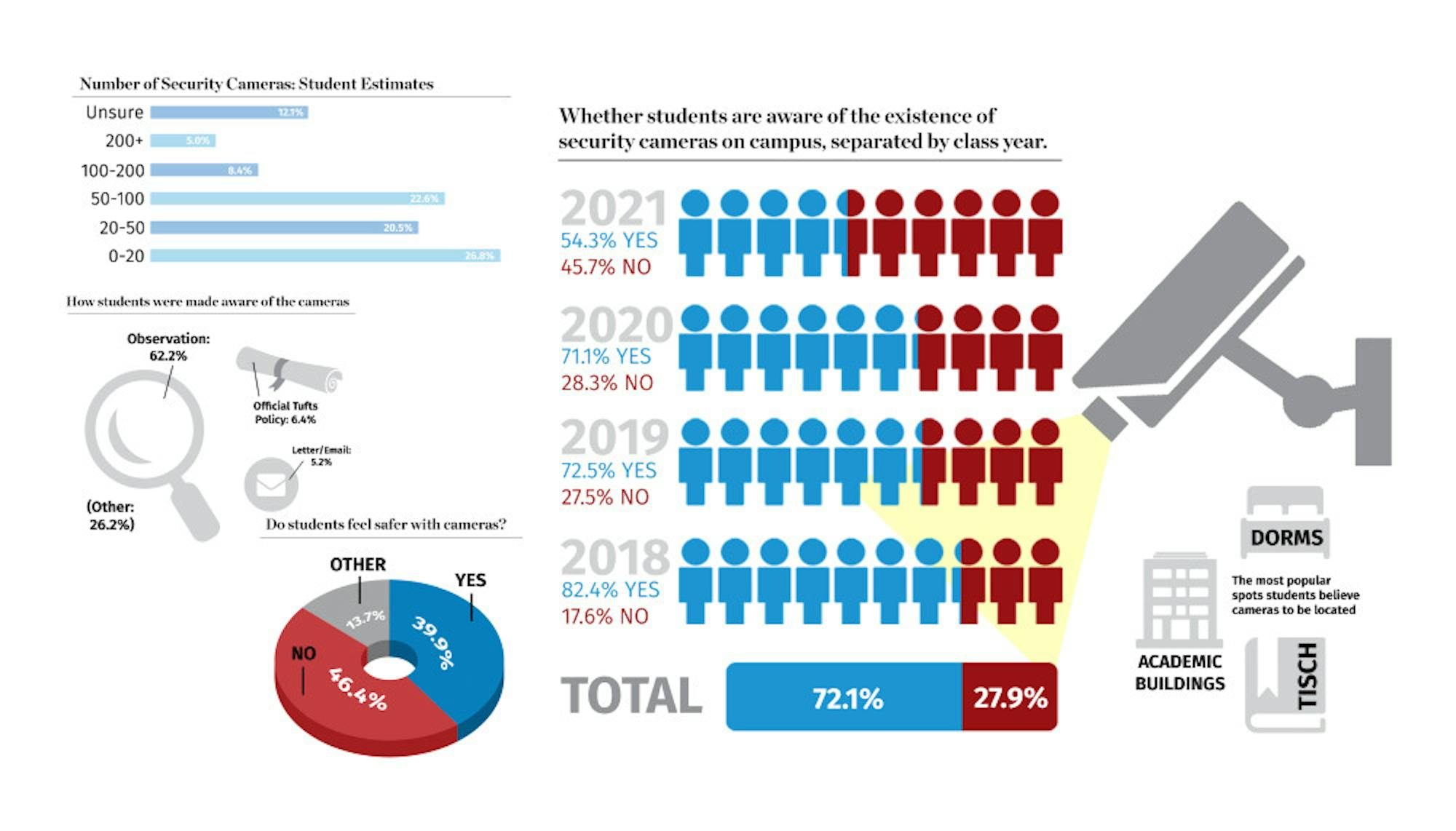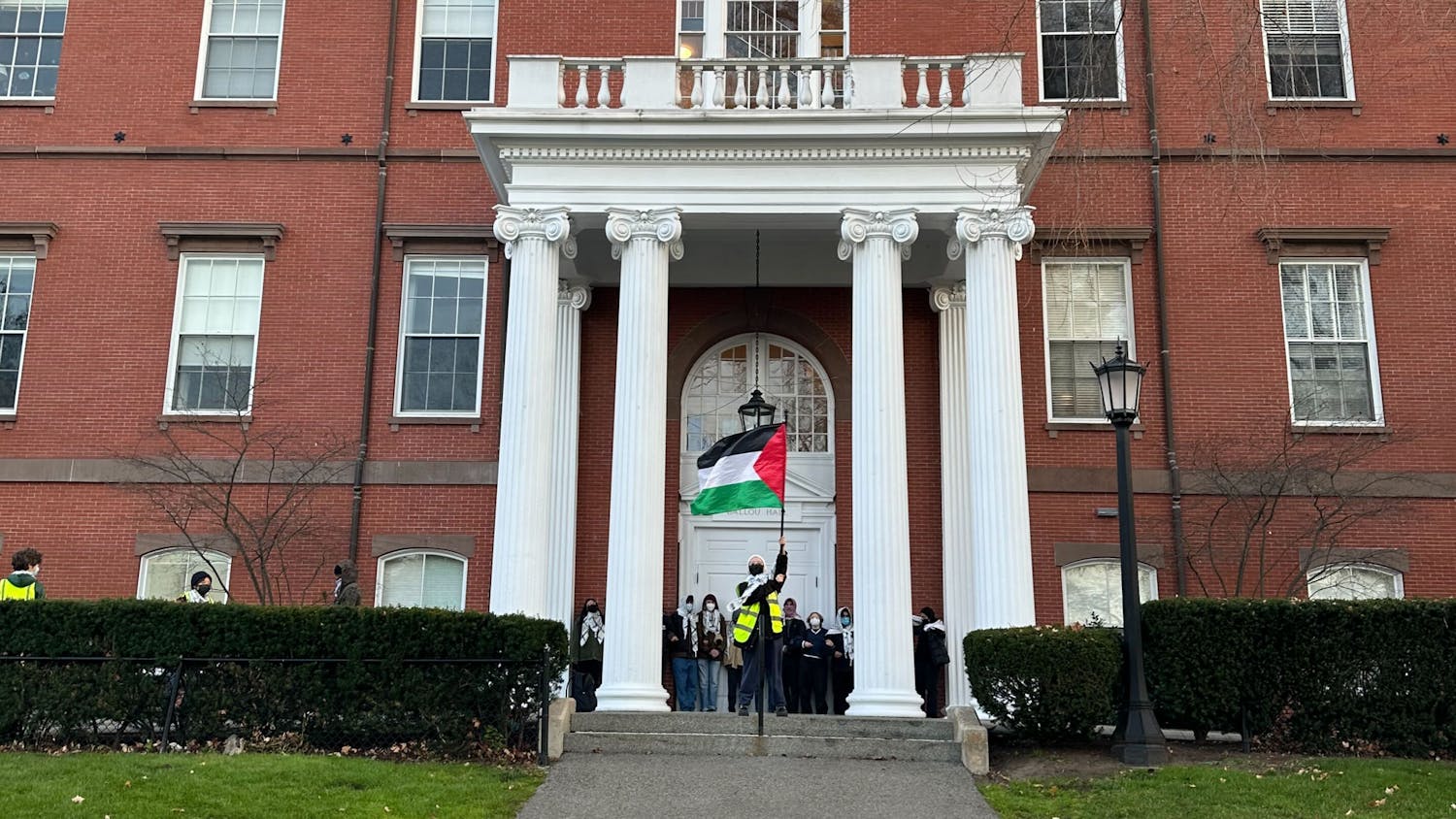Editor's note: This is the first article in a two-part series produced by the Daily's Investigative Team about surveillance on the Tufts campus. The second part will be published on Friday.
In May of 2017, Tufts administrators charged several seniors with various allegations including indecent exposure, sexual exploitation and sexual misconduct after they were found to have participated in the Naked Quad Run (NQR), an event held on May 3 this past spring. NQR had been an annual tradition for Tufts students for decades until the practice was ended in 2011 due to concerns over student health.
Two of the students charged, Robert Sucsy (LA’ 17), who is now a student at the Tufts School of Medicine, and another student who wishes to remain anonymousdue to concerns of further punishment from the administration, said they believe that the Tufts University Police Department (TUPD) used footage from Tufts’ video surveillance system in order to identify seniors who had participated in the event.
“During my meeting with the administration, I was made to feel as if Tufts held proof of my participation in NQR,” the student said. “My conversations ... led me to believe that they used video footage from the security cameras placed throughout campus to identify participants after the fact.”
When asked, TUPD spokesperson Kevin Maguire declined to confirm or deny that video footage was used to identify students.
According to Director of Community Standards Kevin Kraft, video evidence is sometimes used in dealing with student breaches of the university code of conduct and other internal, noncriminal investigations.
“When resolving cases according to the procedures specified in theStudent Judicial Process, we consider all evidence that is submitted,” he told the Daily in an email, specifying that “in some cases, audio, video, or photos are also submitted.”
Tufts has been using a video surveillance policy since 2012, when it spearheaded a program to improve video security on all three campuses. According to the video security website, the primary aim of the program is to “utilize video security as a public safety, emergency response and crime prevention tool on its Boston, Grafton and Medford/Somerville campuses.”
According to Maguire, who also serves as the director of Tufts’ Department of Public and Environmental Safety (DPES) and was the lead director of the surveillance program in 2012, TUPD does not release the placement or number of cameras around campus.
Maguire said that all cameras are visible and that most are on the exterior of buildings and in entranceways.
In addition, Maguire said that video footage is deleted after 30 days unless it is part of an ongoing investigation.
University Vice President Patricia Campbell co-sponsored the project along with former Vice President of Operations Linda Snyder, according to the DPES website. Campbell explained that the university didn’t have a policy for this activity despite already using video cameras on campus prior to 2012. They realized that other colleges and universities had security policies governing their surveillance systems.
Campbell also said that administrators met with Tufts students on all three campuses in an effort to partner with students in the creation of this policy.
At the time, however, concerns about the presence of cameras in general were aired by students and other members of the Tufts community. In September 2012, the Daily published a student op-ed as well as an editorial critiquing the university’s plan to install cameras and create the video security policy.
“Placing security cameras in public meeting places such as the President’s Lawn, academic quads or potentially the roof of the Tisch Library would make many students uncomfortable, and the existing evidence in support of placing these cameras is insufficient to justify community members being monitored,” the editorial reads.
It is important to note that Tufts’ student body, like that of all four-year universities, has almost completely changed in the past four years, and very few, if any, students who would have been present for the 2012 community engagement initiative are still on campus.
Campbell insisted that Tufts has maintained transparency around video surveillance, pointing out that at the beginning of each semester the university sends an email to students reminding them to “familiarize themselves with university policies and how to access them.” These emails do not directly mention the video surveillance policy, and include a link to the Student Affairs webpage.
Of the 233 students who responded to an electronic survey the Daily made available to Tufts students through social media, 62 percent said they first became aware of the cameras due to their own observation. Only 11.8 percent of the respondents knew about the policy by reading the emails sent out by the administration. A total of 31 students said that they did not know there were cameras on campus until taking the Daily’s survey.
“I am not entirely sure what purpose security cameras serve here on campus, and perhaps if I knew more about how the footage was used, I might be more ok with its existence,” one student wrote in response to a question asking if they felt safer on campus because of the cameras.
When asked if they had concerns that their activities were being filmed and could be used by Tufts authorities, 52 percent of students responded “Yes”.
According to Maguire, video surveillance at Tufts is intended to ensure student safety.
"Video security is used as part of an umbrella of safety and security elements … all to enhance safety and security here at Tufts like colleges and universities do throughout the United States," he said.
Campbell echoed this claim, adding that petty crime has decreased since the program has been implemented.
In addition, according to the university’s video security policy, surveillance footage collected on campus can be distributed to local law enforcement such as the Medford and Somerville police departments.
According to Maguire, surveillance cameras are placed where there is “no reasonable expectation of privacy.” However, two students who responded to the Daily’s survey said they needed to ask to have cameras removed from certain locations as a result of privacy concerns.
One student disclosed in the survey that they have had multiple negative encounters with cameras on campus.
“Each one of these discoveries was through the personal experiences of my friends having TUPD make it clear that they 'knew where' my friends were,” they wrote.
According to the online video security policy, the purpose of the cameras is for public safety. “Video security is designed for the protection of people and property, where the main intent is to capture video and store it on a remote device,” explains the policy.
In addition, despite assurances that all cameras are visible, the policy does not prevent the use of other types of video surveillance not made immediately visible to students.
“Mobile or hidden video security equipment may be used in criminal investigations by DPES only. Covert video security equipment may also be used for non-criminal investigations into specific instances that may be a significant risk to public safety, security and property as authorized by the Director of Public and Environmental Safety or designee,” the policy says.
The Daily’s 2012 editorial points out that “the majority of alert emails DPES sent out to community members on the Medford/Somerville campus in the past few years described crimes that took place in areas adjacent to campus, not on campus,” highlighting skepticism about the system’s intended use.
However, the university has the ability to decide when to distribute the recorded surveillance, including noncriminal cases such as the seniors’ violation of university code of conduct due to their participation in the NQR.
“University Relations will seek consultation and advice from the General Counsel related to these requests prior to the release of records,” the policy reads. It is of note that the division University Relations is headed by Senior Vice President Mary Jeka, who also serves as Tufts’ General Counsel.
Additionally, the policy gives DPES the ability to use hidden or mobile cameras in criminal investigations.
Kade Crockford, director of the Technology for Liberty Program at the American Civil Liberties Union of Massachusetts, explained that these kinds of ambiguities in restriction are often the reason video security programs become problematic on college campuses.
“This is an example of what surveillance watcherscall ‘mission creep’,” Crockford said. “Anytime ... a university wants to use surveillance technology, if they choose to explain that to the public and disclose that they intend to purchase the technology and install it, they will often marshall some defense that typically takes the form of public safety. This is why mission creep is such a problem, because if administrations ... do not very clearly delineate how they intend to use technologies like surveillance cameras, it’s almost inevitable that they will be used for purposes the advocates did not initially explain to the rest of the community.”
UPDATE: This article has been updated to clarify what Tufts began doing with regards to video surveillance in 2012.
Video surveillance: who's watching Tufts' campus?

Amy Tong / The Tufts Daily





